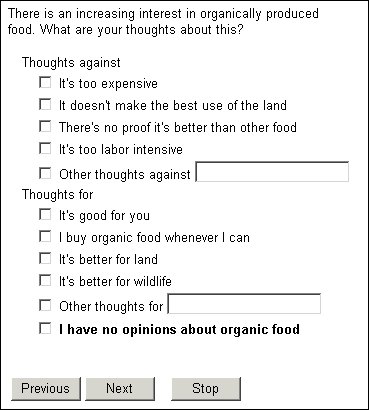Subheadings in response lists
Subheadings are a means of grouping similar or related responses in a list. For example, if the response list contains a number of statements about a product, you might group the responses according to whether they are favorable or unfavorable comments. If there are many responses or the response texts are long, this immediately helps respondents find the general type of comment they want to make. Similarly, in a list of cars, you might use the different makes of car such as Ford or Volkswagen as subheadings and then list the various models under the appropriate subheadings. As before, this makes it easy for respondents to find specific answers in the list (it’s also easier for you or anyone else who needs to add responses to the list).
Syntax for defining subheadings
Qname "Text" categorical [[NumChoices]]{
Subhead_name1 ["Subhead_text1"]
{
Responses
}, ...
Subhead_namen ["Subhead_textn"]
{
Responses
}
};
Notice in particular the comma that separates the subsections. Each subsection has a subheading followed by a collection of responses enclosed in braces, and each subsection is separated from the next by a comma.
Parameters
Qname
The question name.
Text
The question text.
NumChoices
The number of responses that must be chosen. If you omit this parameter, respondents may leave the question unanswered.
Subhead_name1 to Subhead_namen and Subhead_text1 to Subhead_Ttextn
The subheading names and display texts (labels).
Responses
The responses from which the choices may be made, specified with names and display texts if appropriate.
Example
In the following example, responses have been grouped under two subheadings:
OrganicFood "There is an increasing interest in organically produced
food. What are your thoughts about this?" categorical [1..]
{
AgainstOrganicFood "Thoughts against"
{
Expensive "It's too expensive",
NotGoodLandUse "It doesn't make the best use of the land",
NotProven "There's no proof it's better than other food",
LaborIntensive "It's too labor intensive",
OtherNegative "Other thoughts against" other
},
ForOrganicFood "Thoughts for"
{
GoodForYou "It's good for you",
BuyItMyself "I buy organic food whenever I can",
GoodForLand "It's better for land",
GoodforWildlife "It's better for wildlife",
OtherPositive "Other thoughts for" other
},
NoThoughts "I have no opinions about organic food" exclusive
};
When this question is displayed during an interview it looks like this:
If you have responses with identical names in more than one subsection, you will need to use namespacing to force the response names to be unique. For more information, see
Responses with duplicate response names.
See also

